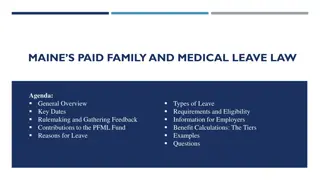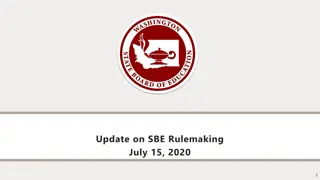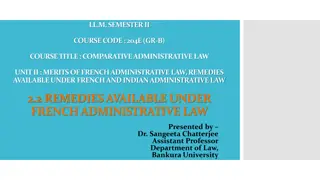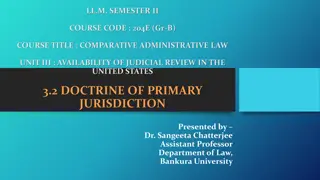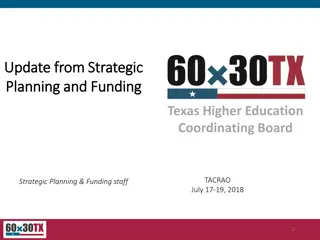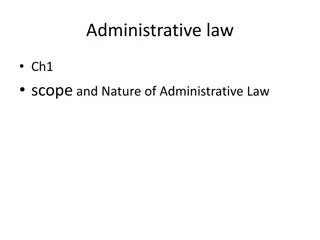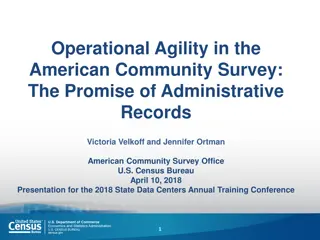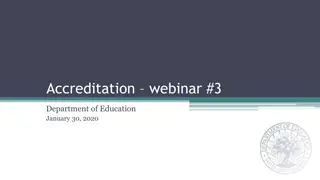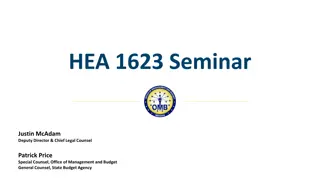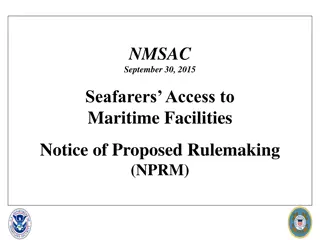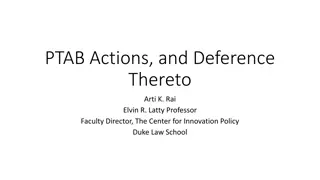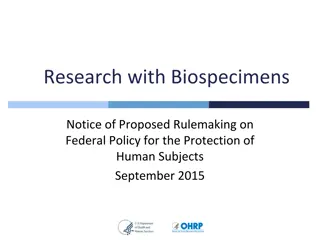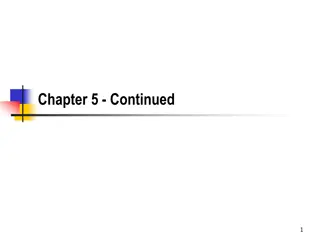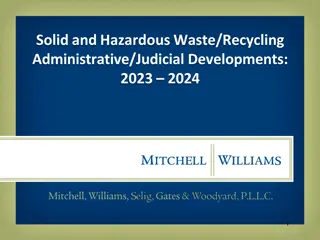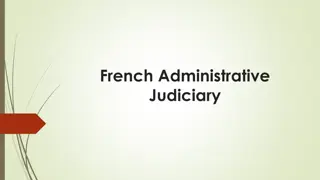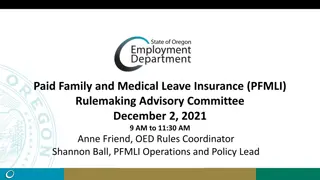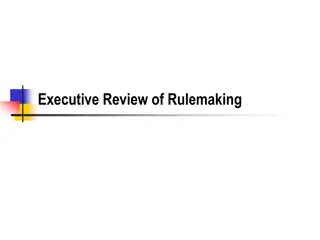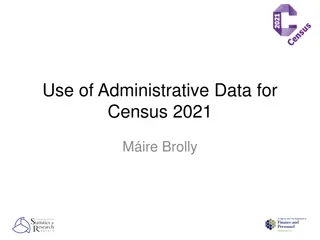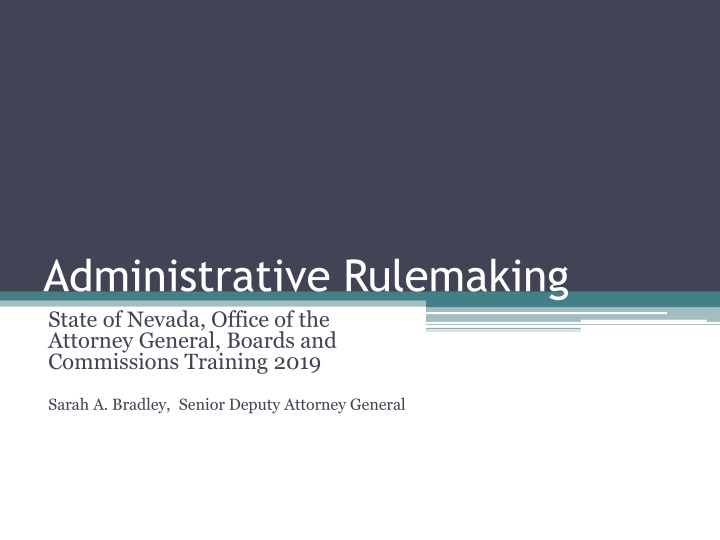
Administrative Rulemaking in Nevada: A Comprehensive Overview
Explore the intricacies of administrative rulemaking in Nevada, including definitions, regulations, and what distinguishes regulations from other agency decisions. Learn about the importance of clarity in establishing regulations and how to identify what should be considered a regulation. Delve into a Nevada Supreme Court case highlighting the significance of adhering to regulatory policies.
Download Presentation

Please find below an Image/Link to download the presentation.
The content on the website is provided AS IS for your information and personal use only. It may not be sold, licensed, or shared on other websites without obtaining consent from the author. If you encounter any issues during the download, it is possible that the publisher has removed the file from their server.
You are allowed to download the files provided on this website for personal or commercial use, subject to the condition that they are used lawfully. All files are the property of their respective owners.
The content on the website is provided AS IS for your information and personal use only. It may not be sold, licensed, or shared on other websites without obtaining consent from the author.
E N D
Presentation Transcript
Administrative Rulemaking State of Nevada, Office of the Attorney General, Boards and Commissions Training 2019 Sarah A. Bradley, Senior Deputy Attorney General
Administrative Rulemaking Manual The Office of the Attorney General publishes an Administrative Rulemaking manual. Contains a summary of requirements in NRS 233B for rulemaking, a sample checklist, and forms required in rulemaking. Location (old version from 2014): http://ag.nv.gov/uploadedFiles/agnvgov/Content/P ublications/RulemakingManualComplete.pdf Go to ag.nv.gov and click on publications under AG Leadership on the main page, then manuals and guides and then Administrative Rulemaking Manual. Rulemaking process is found in NRS Chapter 233B.
What is a Regulation? Defined in NRS 233B.038(1)(a) Interpretation of Law Description of Agency Practice or Rule (requirement!) Agency Standard Key Phrase: General Applicability Applies to the public in general or to all licensees. Contains a mandatory requirement or standard that the agency will use. Affects private rights or procedures available to the public.
What is NOT a Regulation? Guidelines governing the internal management of the agency, such as internal policies and procedures regarding day-to-day business. Example: Desk manual which provides procedures for opening and sorting mail, preparing bank deposits, etc.
Regulations are also NOT Declaratory rulings or orders, Agency decisions or findings in a contested case, and Advisory opinions issued by the agency that are not of general applicability. Why? Because these are NOT of general applicability these items deal with specific situations and specific sets of facts. They are not mandatory for everyone to follow.
When In Doubt, Consider a Regulation With few exceptions, anything you want the public and/or licensees to know about and/or follow should become a regulation. If it was not on the previous not lists, it probably should be a regulation.
Why? Dunning v. Nevada State Board of Physical Therapy Examiners, Nevada Supreme Court Case No. 67322, filed May 26, 2016. In 2013, the Board adopted a policy prohibiting licensees from using the terms osteopractic or osteopractor in any manner, including advertising. The Board published this policy on its website and by sending it to all licensees in a newsletter. The Board did not engage in rulemaking with regard to this policy, i.e., turn it into a regulation.
Market Participants The Nevada Supreme Court held that this policy was a regulation because it was of general applicability. [W]here an interpretive ruling affects other market participants, appears to be part of a general policy, and is of such major policy concern and of such significance that it may be characterized as being of general applicability, the ruling is a regulation. Dunning, at 4 quoting State Farm Mut. Auto Ins. Co. v. Commissioner of Ins., 114 Nev. 535, 543, 958 P.2d 733, 738 (1998).
General v. Specific Declaratory, decisional, advisory, and fact- specific interpretive rulings are NOT regulations. Dunning, at 4 citing NRS 233B.038(2)(b), (e), (f) and (h). It becomes general when the intent is that everyone must follow the ruling or interpretation. Example: Requiring or prohibiting conduct from all licensees.
Creating a Legal Standard In Dunning, the Court said that the Board s policy plainly applies to every physical therapist licensed in the State of Nevada and to any potential use of the [named] terms. Dunning, at 5. The Court concluded the policy effectuates law or policy. Id. Under these facts, the policy is a regulation pursuant to NRS 233B.038. Id.
Now What? If the Board wants to require all licensees to do something MAKE A REGULATION. Example: Probation, internship hours, providing specialty area of practice in renewal. If the Board wants to prohibit all licensees from doing something MAKE A REGULATION. Example: Misleading advertising, outside the scope of practice. In general: MAKE A REGULATION. Define terms, scope of practice, etc.
Force and Effect of Law A properly adopted substantive rule establishes a standard of conduct which has the force of law. State ex rel. Tax Comm n v. Safeway, 99 Nev. 626, 630, 668 P.2d 291, 294 (1983). See also NRS 233B.040(1) ( If adopted and filed in accordance with [NRS Chapter 233B] . . . have the force of law. ). This means that, after adoption by the agency, a regulation has the same power and effect as a law passed by the Legislature. For example, a licensee of a state agency, must conform his/her actions to those specified by both statutes and regulations for that agency.
Who Can Make Regulations? Must have authority in the NRS from the Legislature Enabling Statute Broad based, ex. NRS 385.080: State Board of Education is authorized to . . .adopt regulations for its own government and as necessary for the execution of the powers and duties conferred upon it by law. Specific, ex. NRS 388.133: Department of Education required to . . .prescribe by regulation a policy for all school districts and public schools to provide a safe and respectful learning environment that is free from bullying and cyberbullying.
Authority Generally Limited: Generally, authority to make regulations is limited in some way. See NRS 641.100: The Board may make and promulgate rules and regulations not inconsistent with the provisions of this chapter governing its procedure, the examination, licensure and certification of applicants, the granting, refusal, revocation or suspension of licenses and certificates, the practice of psychology and the practice of applied behavior analysis. (emphasis added) Carrying out the agency s functions (i.e., licensing, discipline, etc.), or Ensuring proper execution of functions (i.e., hearing format, etc.)
Special Subject Areas For monetary sanctions , penalties, or fees, the agency must have specific NRS authority authorizing the regulation. Authority to make regulations regarding licensing does not provide authority to institute an application fee for licensure by regulation, there must be a statute authorizing a Board or Agency to charge a fee for the application. To obtain fingerprint records for applicants, the agency must have specific NRS authority authorizing the agency to require fingerprint cards be submitted by licensure applicants.
Areas Where Regulations are Required NRS 233B.100 Petitions regarding regulations. Required for all agencies with regulation-making authority. NRS 233B.120 Petitions for declaratory orders and advisory opinions. Required for all agencies with contested case decision- making authority. See also NRS 233B.031 (defines agency and makes the distinction between regulation-making authority and contested case decision-making authority). Check NRS Chapters for regulation tasks that have been assigned by the Legislature and not yet completed.
When in Doubt Check your enabling statutes for the parameters. Ask your assigned Deputy Attorney General for guidance. Don t enact a policy instead of a adopting a regulation. Don t enforce a requirement or restriction, if you have not adopted a regulation.
Types of Regulations Permanent Temporary Emergency
Permanent Workshop LCB Review Adoption Hearing Resubmitted to LCB Legislative Commission File with SOS Between July 2 odd years and June 30 even years **Most common**
Temporary Workshop No LCB Review Adoption Hearing No Legislative Commission, unless requested by a Legislator File with SOS, no sooner than 35 days after the date the temporary regulation was adopted Between August 1 even years and July 1 odd years Expires on November 1 of the odd year, permanent regulation must be adopted to continue.
Emergency No Workshop No LCB Review No Adoption Hearing Submission to Governor with statement describing emergency which requires the regulation Governor Signs File with SOS Good for 120 Days
The Drafting Process Step One: Draft the regulation language or draft a summary of the regulation change needed. Step Two: Consider the impact of the proposed regulation on small businesses and prepare a small business impact statement. If there is an impact, the Agency must conduct an analysis of the likely impact of the regulation on small business. The analysis may be conducted by someone employed by the Agency who is most knowledgeable in the subject area or an outside consultant.
The Drafting Process Step Three: Conduct at least one workshop to discuss the general topic or topics covered by the proposed regulation. Step Four: Submit the proposed regulation text to the LCB or submit the summary of the regulation change needed and ask LCB to draft regulation.
The Drafting Process Step Five: After receiving the proposed regulation back from LCB, review regulation to ensure intent of the regulation is incorporated, prepare and post the Notice of Intent to Act Upon Regulations. The agency must provide 30 days notice of the public hearing, and the LCB draft of the regulation must also be posted for 30 days, along with the Notice. Step Six: Receive public comments about the proposed regulation at a public hearing.
The Drafting Process Step Seven: Consider the comments received from the public and business affected by the proposed regulation. Step Eight: Final Adoption. Step Nine: Return Adopted regulation to LCB for inclusion in the next Legislative Commission meeting.
Drafting the Text Include a citation to the NRS authority authorizing the agency to make the regulation. Goals in writing are accessibility, clarity, and conciseness. NRS 233B.062. Gender neutral language.
Drafting the Text Look for related or relevant NAC provisions from other agencies, some may provide helpful guidance. Try to be consistent with the language found in other sections of NAC within your chapter. Include the whole section of NAC being amended. Do not include the entire chapter of NAC if you are not amending it all.
Drafting the Text For the new language make the font colored, i.e. not black Include [brackets and strikethrough ] in the language you are proposing to be deleted Not required to be written by the Agency s attorney. For cost saving, it is recommend that it be drafted by agency, reviewed by DAG for clarity, and extensively reviewed by LCB as required by NRS Chapter 233B. See Administrative Rulemaking Manual pages 13-19 for more specific drafting guidance.
Small Business Impact Before conducting a workshop on a proposed regulation, the agency must make a concerted effort to determine whether the regulation is likely to [i]mpose a direct and significant economic burden upon a small business or [d]irectly restrict the formation, operation or expansion of a small business. NRS 233B.0608(1). If the agency believes there will be such an impact it must pursuant to NRS 233B.0608(2): If practical, consult with owners and officers of small businesses likely to be affected, Conduct an analysis of the likely impact of the proposed regulation on small businesses. The analysis must be conducted by the employee of the agency who is most knowledgeable about the subject of the regulation and the likely impact or a consultant or independent contractor Consider methods to reduce the impact of the regulation on small businesses, and Prepare a small business impact statement and make copies of the statement available to the public at the workshop and public hearing on the regulation.
Small Business Impact For all regulations, the agency must prepare a statement identifying the method used by the agency to determine small business impact. NRS 233B.0608(3). Requirements for small business impact statement are found in NRS 233B.0609.
Workshop Schedule a workshop to discuss the proposed language of the regulation. Notice must be posted 15 days before the workshop and an electronic copy of the notice must be submitted to the Director of LCB for posting on LCB s website: http://www.leg.state.nv.us/App/Notice/A/ Agency is required by law to have a mailing list of persons interested in regulatory changes. Hearing on the regulation cannot occur on the same day as the workshop. Incorporate any input from the workshop into the regulation.
Workshops Proposed language is not required at workshop. Sample Notice for Workshop in Appendix C of Administrative Rulemaking Manual. All workshops MUST be conducted in accordance with Nevada s Open Meeting Law, NRS Chapter 241. NRS 233B.061(5). Minimum Open Meeting Law Requirements: Agenda, (Posted as required by the Open Meeting Law and on the LCB site) Recording, and Minutes.
Submission to LCB (Pre-Adoption) The agency must deliver a copy of the proposed rule to the Legislative Counsel Bureau at the start of the rulemaking process. NRS 233B.060; NRS 233B.063. By e-mail to LCB: Regulations@lcb.state.nv.us Regulation will be assigned an R#. NRS 233B.063 requires that the LCB review the regulation to determine whether the language is clear, concise, and suitable for incorporation in the NAC.
Submission to LCB (Pre-Adoption) LCB will draft the regulation to carry out what it can determine is the intent of the regulation. The Agency should review the language of the proposed regulation after LCB has drafted it to ensure that the regulation carries out the intent of the Agency. If it does not, contact LCB to discuss the intent and possible revisions to the regulation to ensure it carries out the intent.
Submission to LCB (Pre-Adoption) LCB is required to draft the regulation within 30 days pursuant to NRS 233B.063(2). However, if LCB has questions concerning the regulation, the Agency must ensure someone is available to answer those questions to ensure this timeline is met. Occasionally with more substantive regulations, drafting may take longer than the 30 days. LCB will review authority for a regulation and ensure that the agency may adopt a regulation in that subject area.
Notice of Intent to Act Upon Regulations Prepare and post the Notice of Intent to Act Upon Regulations. This Notice is the notice for the date, time, place of public hearing. Must be submitted to the Director of LCB for posting on LCB s website 30 days notice is required. Notice may not be given UNTIL after the agency receives the approved or revised text of the proposed regulation from the LCB. Requirements of Notice are codified in NRS 233B.0603. The Office of the Attorney General adopted a regulation, NAC 233B.010, that specifies the form of the Notice. **NEW in 2017 SB160: For first public hearing, post proposed regulation on the agency website for at least three (3) working days prior to the public hearing date. For subsequent hearings, to amend regulation draft, give three working days notice of intended action.
Notice of Intent to Act Upon Regulations See Appendix B of Administrative Rulemaking Manual for copy of the form required for the Notice and should be used in all cases to provide the required notice of rulemaking. Because this form does not satisfy the Open Meeting Law requirements for an agenda, a separate agenda for the public hearing must also be prepared. Don t forget to post this agenda on the LCB site.
Who Gets the Notice? When Notice is given, provide a copy of the Notice and the proposed text of the regulation to the State Library and Archives Administrator. One copy to the Director of LCB for posting on LCB s website: http://www.leg.state.nv.us/App/Notice/A/ Also, send a copy in word format to Deb Corp at dcorp@lcb.state.nv.us for posting to the Register One copy of the Notice and text of proposed regulation must also be kept in each of the agency s offices. Send one copy of Notice and text of proposed regulation to the main public library in any county where the agency does not maintain an office. See Appendix D to Administrative Rulemaking Manual for a list of all main public libraries in Nevada.
Who Gets the Notice? Send copies to all persons on the agency s mailing list for regulations. Affirmative duty to solicit comment on proposed regulations and provide notice to the public. In general, the more notice provided, the better. May provide notice to other public and private places, such as courthouses and offices of businesses or professional associations.
The Public Hearing (Adoption) At the time and place set for hearing on the proposed regulation, the agency must afford [a]ll interested parties . . . a reasonable opportunity to submit data, views or arguments upon a proposed regulation. NRS 233B.061(1). The agency must accept both oral comments at the public hearing and written comments. The agency must set a deadline for receipt of written comments, keeping in mind the need for those acting on the proposed regulation to have time to consider all comments received prior to adoption.
The Public Hearing All public hearings MUST be conducted in accordance with Nevada s Open Meeting Law, NRS Chapter 241. NRS 233B.061(5). Minimum Open Meeting Law Requirements: Agenda, Recording, and Minutes. The minutes of the hearing are a public record and must be available for public inspection and should be included in the agency s file for the regulation and retained for at least 5 years. For more information regarding the Open Meeting Law: NRS Chapter 241 Open Meeting Manual, published by the Nevada Attorney General s Office online at http://ag.nv.gov/ (click publications, manuals and guides, Open Meeting Law Manual.)
Consideration of Public Comment The person or body with the authority to adopt the regulation must consider fully all oral and written comments received on the proposed regulation. NRS 233B.061(3). In some cases the hearing may be held at the same time as a public meeting of the board or commission called to consider and take action on the regulation. In that case, since the members will have been present for the taking of public comments and may review any written comments previously submitted, this would appear to be an efficient means of complying with this requirement, provided that the members take the time to discuss the comments received in the public meeting prior to adoption.
Consideration of Public Comment Boards or commissions considering the public comments on proposed regulations should retain in the minutes a record of their discussion regarding the public comment and their reasons for either amending the proposed rule in response to the comments or adopting the rule without change.
Adopting the Regulation with Changes Generally speaking, if the text of the proposed regulation changes substantively as a result of public comment that it must be again submitted to LCB for review prior to adoption. LCB will draft a revised proposed regulation and the Agency will have to post a notice and consider comments before adoption If the changes are not substantive, an agency may adopt the regulation with those changes.
Adopting the Regulation with Changes Do not avoid making needed changes because the process may be extended. The proposed regulations will eventually become law, and it is important that it meets the Agency s intent and the needs of the Agency and the public. To avoid problems, the Agency s attorney should be consulted regarding changes.
Two-Year Time Period An Agency has two (2) years from the date the proposed regulation was submitted to LCB for drafting to adopt it. If the agency does not adopt it within the two (2) years, the executive head of the agency must appear before the Legislative Commission before it moves forward with adopting the regulation To appear before the Legislative Commission regarding an old regulation email LCB at Regulations@lcb.state.nv.us to be placed on the agenda for the next Legislative Commission meeting.
Two-Year Time Period Review the Agency s pending regulations and withdraw any regulations that the Agency is not going to pursue by sending an e-mail to Deb Corp requesting that the regulation be withdrawn. Recommendation: Any regulations that are outside this two-year time period should be withdrawn and the process restarted for any that the Agency still wishes to pursue. An agency may withdraw a regulation by submitting an email requesting it be withdrawn to LCB at Regulations@lcb.state.nv.us.
Final Adoption Adopt the regulation and file the original with the LCB. Upon its filing with the Secretary of State by the LCB, file a conformed copy with the State Library and Archives Administrator. Items to file with the LCB: Original, final copy of the regulation, Informational statement required by NRS 233B.066, which must include an explanation concerning the need for the regulation Form for Filing Administrative Regulations, and The form Notice of Adoption of Regulation (see Appendix F to Administrative Rulemaking Manual). Regulation will now be reviewed and approved by Legislative Commission or Subcommittee to Review Regulations. See NRS 233B.066 for information required in Informational Statement. See also Appendix G of Administrative Rulemaking Manual.
Review by LCB (Post-Adoption) After a regulation is adopted, the Agency must submit a copy of the regulation, together with the informational statement required by NRS 233B.066 and the Form for Filing Administrative Regulations to the LCB. The informational statement must include a statement regarding the need for the regulation. Ensure that the informational statement is thoroughly filled out along with a clear explanation as to the economic effect of the regulation. If the Agency does not provide the informational statement or the small business impact statement, LCB will return the regulation to the agency indicating the missing documents. Unless the documents are supplied, LCB will not submit the regulation to the Legislative Commission.
Legislative Commission Legislative Commission will review regulation for conformity with legislative authority and intent after it has been adopted and approve the regulation before it becomes effective. Regulation will be reviewed at the Legislative Commission s next scheduled meeting or be referred to Subcommittee to Review Regulations. For permanent regulations, affirmative action by the Legislative Commission or Subcommittee to Review Regulations is required to approve or object to a regulation. If no action is taken by the Commission or Subcommittee, the regulation does not become effective.

